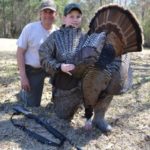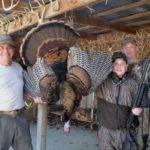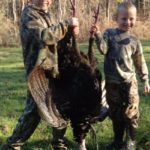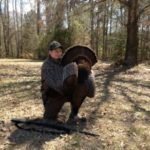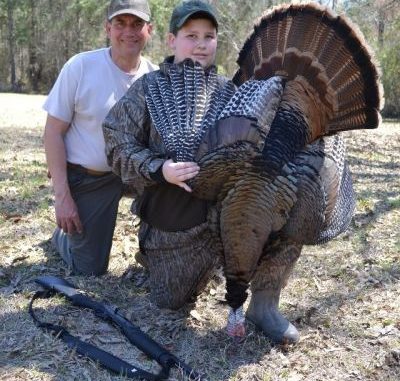
Keeping young turkey hunters interested in the sport is all about action, and sometimes getting a turkey close enough for a shot requires some extra effort. Here’s how one youngster bagged his first gobbler.
Twelve-year-old Dane Humbles tightened his grip on the shotgun and sighted down the barrel as the big gobbler closed the distance in a quick trot.
Whatever was going to happen was going to happen fast. It was not even noon yet, and Dane had already experienced the lows and highs of spring gobbler hunting.
The date was Saturday, March 16, the opening day of the youth turkey hunting weekend for 2013 in Louisiana’s turkey hunting Area A. This hunt had been planned and anticipated for over a year.
Dane’s father, David Humbles, leases some prime Mississippi River bottom-land near Natchez. Over the years my son Darin and I have enjoyed some top-quality deer hunts with David and Dane. So when David told me Dane was interested in taking a spring gobbler, I was thrilled to extend an invitation for the 2012 youth hunt.
But those plans hit a snag when I discovered the club rules for the private land I lease, along with 24 other club members, prohibited guests on youth and opening weekends of gobbler season. We did not have time to propose a rule change prior to the 2012 season, so things were put on hold until the following year.
In anticipation of the 2013 season, our membership voted unanimously to allow any qualifying youth to hunt as a member’s guest during youth hunts, clearing the way for Dane.
During the week leading up to that Saturday, I scouted the lease for gobbling birds. Turkeys are fairly plentiful on our lease, but the middle of March is early and a little ahead of the gobbling and breeding peak for mature birds. Hens are still bunched and jakes and 2-year-old birds are gobbling some.
But big, mature gobblers with deep, throaty gobbles, long beards and needle-sharp, curving spurs aren’t saying much yet.
I did, however, manage to hear a couple of mature birds gobbling a few times at daybreak. Mid-morning glassing revealed several gobblers strutting and displaying for the hens on food plots, open roads and the two miles of power line right-of-way running through our lease.
I selected a spot on the power line where a big gobbler was roosting regularly, and placed a pop-up blind at the edge of the clearing, offering a good view.
Stashing two folding chairs and a pair of hen decoys in the blind, I was confident this was as good a place as any to be sitting on opening morning.
Sitting in a blind with decoys out front might not offer the mobility experienced turkey hunters use to their advantage on moving gobblers. But a blind conceals movement, and hen decoys will at times make a gobbler throw caution to the wind, giving a beginner better chances for success.
Well before daybreak that Saturday morning we checked in at the camp. Fellow lease member Keith Brunson and his 11-year-old son Connor Brunson were already on hand. Joining Keith and Connor were Keith’s friend Cliff Gee and his 5-year-old son Jackson Gee.
Cliff is an experienced turkey hunter, successful in a number of states. Keith and Cliff had scouted around some on Friday and were optimistic.
We wished each other good luck and moved out to our chosen locations. David Humbles decided to stay at the camp and prepare breakfast, while Dane and I went to give the old gobbler a try.
Dane and I were in the blind with the decoys set out well before the first light. As day began to break, cardinals and a few other song birds woke up and let go with a few notes. Minutes later an owl hooted and a gobbler answered.
Within seconds another gobbler sounded off.
I estimated the birds to be no more than 300 yards distant and not far off the power line. Dane was pretty excited, and I had hopes this was going to work out.
But neither gobbler responded to my hen clucks and yelps, and after a few half-hearted gobbles both birds went quiet.
Early morning fog wasn’t helping, since turkeys are hesitant to leave the safety of the roost tree in such weather.
This was not what I had hoped for, but we were still optimistic, hoping the gobblers would come off the roost and out to the open power line where they would see the decoys and come strutting in.
It didn’t happen.
Dane is an experienced young deer hunter and was very patient. But I decided a break was in order after a couple of hours. So we slipped out of the blind, stowed the decoys and returned to the camp for some of David’s breakfast and a mid-morning strategy session.
Keith, Connor, Cliff and Jackson had already returned to the camp with big smiles and a beautiful gobbler Connor had bagged.
Connor was thrilled and excited all over again as he told the story of his hunt.
They had gone to the far end of the power line and found three big gobblers still grouped together. Cliff had used decoys and “fighting purr” calls to get all three gobblers mad enough to come within range of Connor’s 20 gauge shotgun.
And then there were two.
The weather had cleared, and we now had a sunny spring morning. Dane and Jackson still had birds to kill, so after breakfast we decided to go check a few spots for late-morning turkey activity.
As soon as the sun dries off the morning dew, turkeys will commonly move into open areas to feed, display and enjoy the warm sun.
David decided to ride along with us, so he, Dane and I took off a few minutes ahead of the other guys.
I never drive past the power line without stopping to look for turkeys, so just before getting to the road and power line intersection I pulled off, got out and slipped up to where I could see in both directions on the right of way.
Sure enough, a nice bunch of turkeys were visible from the road about 400 yards up the power line. I could see three gobblers in full strut, showing off for a half dozen hens that were ignoring them and feeding along.
I motioned for David and Dane to get out of the truck and walk up for a look. We were admiring the turkeys and discussing plans for a stalk when the Brunsons and Gees drove up and parked behind my truck.
They took a look at the birds with us.
My plan was to sneak within calling range and try to pull the gobblers close enough for a shot. But it was not going to be easy.
This situation usually resulted in nothing more than calling uselessly from afar while the turkeys paid no attention and kept right on doing what they were doing.
I said as much, and that was when Cliff put forth a rather unusual idea for a team effort. It sounded a little goofy, but we had nothing to lose, time on our hands and Dane was willing to try.
So we donned our camo. Dane grabbed his shotgun, and Cliff got a strutting gobbler silhouette decoy and full-body hen decoy out of the truck and off we went.
We had good cover in standing timber running parallel to the power line right of way. So we stayed well back in the trees out of sight of the power line and closed the distance to about 150 yards from the turkeys.
At that point we carefully slipped up to the edge of the opening, where Dane and I took up position at the base of a tree. We could not see the turkeys from here, but Dane was facing up the power line toward the turkeys last known position.
We hoped they had not gotten suspicious and departed.
Cliff popped a diaphragm call in his mouth, folded out the gobbler decoy, perched the hen decoy on its stake and belly crawled out onto the open power line right of way, holding the decoys up and facing them toward the turkeys.
He was somewhat hidden behind the decoys. From his flat, face-down position in the clearing he could see the turkeys and whispered to us that the now-alert birds were still there.
Here is where things got goofy.
Cliff began to putt and cluck aggressively on the diaphragm call, and urged me to do the same.
While calling, he began moving the decoys he stilled clutched in each hand, giving them some agitated motion. He threw in a couple of gobbles amid putts and clucks, and reported the hens had moved into the timber — but the three gobblers (which turned out to be two jakes and a long beard) were still there and showing some interest.
Dane and I still could not see a thing except Cliff and his bobbing decoys, which reminded me of an old-fashioned puppet show.
I was trying not to laugh out loud, but got serious when Cliff said the gobbler had run the two jakes off and was now coming our way.
“Call!” he whispered, and I did.
I heard the gobbler answer.
“He’s coming on the run!” Cliff said. “Get ready!”
Cliff was well to our left and slightly behind us, so Dane had a clear, safe field of fire. He was seated comfortably with the shotgun well positioned on his knees, and the barrel looked to be rock solid.
The gobbler suddenly came into view. With head bright red and long beard swinging, he came on at a fast trot.
Maybe that gobbler silhouette or the hen on a stick was starting to look funny, or maybe it was the man laying on his belly right behind them that gave him pause.
Either way the gobbler suddenly hit the brakes and came to a standstill no more than 20 yards from Dane.
The shotgun roared and the gobbler folded cleanly.
We all jumped up and danced our way to the fallen bird, where we congratulated Dane and each other.
Within what seemed like only seconds, Dane’s dad, David, was on the scene. For a big guy he had covered the distance pretty fast, and was as excited as we were.
Dane had a beautiful long-beard with good spurs, and a first turkey hunt he will never forget.
We tagged the gobbler and snapped some photos, and then hustled back to the camp where we took more photos and logged in the kill in the camp records book.
David and Dane were already talking about having the gobbler mounted, so they decided to head for home to get Dane’s trophy in the freezer ASAP.
The only one of our youth-hunt trio yet to shoot a gobbler was Cliff’s son Jackson. So he and Cliff headed out to see what they could do.
They had lots of daylight left, and I had little doubt they would find birds and get some action.
Sure enough, I got word the next day that Cliff had found a flock that afternoon with three gobblers, two jakes and several hens. He had been able to lure one of the jakes into range of young Jackson’s .410, making our youth hunt Saturday a three-bird grand slam.
What a way to start the season.
I vividly recall my own son Darin’s first gobbler. The big long-beard was one of two toms that waltzed into range early one morning, gobbling all the way. Darin was seated between my legs and rolled that big bird like a pro.
Before long the grandkids will be ready for their fist turkey hunt. I better start practicing crawling with a turkey decoy in each hand.
